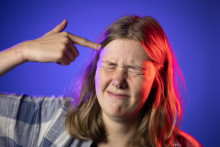This time we go see the movie ‘Joker’ (2019) together with Mirjam Radstaak, Assistant Professor at the department of Psychology, Health and Technology, whose research focuses on mental health. We have popcorn. We have a bottle of soda. We both have a notepad and a pen. We are prepared for the screening. What does a psychologist think as she watches a story of a mentally-troubled man turning into a supervillain in Gotham City?
The beginning
We meet Arthur Fleck (played by Joaquin Phoenix). Recently released from a mental hospital, he is working as a clown and struggling to provide for himself and his sick mother who is essentially the only person in his life. Arthur gets repeatedly beaten and humiliated on the streets. His condition that forces him to laugh uncontrollably at random moments certainly doesn’t make his life easier. He attends therapy but the funding gets cut and Arthur is left without access to medication. After losing his job and after yet another beating on subway, he – dressed as a clown - shoots his attackers.
First impression
Ten minute break in the cinema gives us time to discuss first impressions. Radstaak, scrolling through a PDF on her phone, says: ‘I’m looking at various personality disorders, but I’m not sure if he has any yet. However, the laughing condition is a real thing. It is called involuntary emotional expression disorder. It is associated with several different neurological disorders related to the prefrontal cortex. What strikes me the most is Arthur’s lack of elemental social skills. He writes down notes of having to make eye contact and why certain jokes are funny. He is not really capable of understanding others, but the thing is: he is trying. He is really doing his best.’
'He is really doing his best'
The end
The movie continues. The media interpret Arthur’s murders as an act of ‘revenge against the rich of the city’ and the (to the public unknown) ‘clown killer’ becomes idolized by the masses. And thus begins Arthur’s transformation into Joker, a change that is accelerated by the discovery that he was adopted and that his mother mistreated him as a child. A few murders further, Arthur begins to accept his dark alter ego and once he kills a TV presenter during a live show, there is no going back. Joker is born.
Realism / feasibility
Radstaak: ‘Now I can think of a whole bunch of diagnoses. He was abused so he could be suffering from a trauma. He has depressive symptoms. What fits very well, however, is an antisocial personality disorder. He shows no remorse for the killings. He lacks conformity. He demonstrates recklessness to safety of himself and others. All descriptions of antisocial personality.’
‘However, you could argue that his actions were a result of his surroundings. He was probably adopted. Adoption is a break in the relationship with your mother. It can influence your attachment style, you might get difficulties bonding with people. He was abused as a child. His medication is taken away. Those are all risk factors for pathologies and his environment is certainly not supportive. It pushes him to the murders. He loses his social support. He loses his mom and his dream dad, all parental figures.’
'I’d say the transformation into a villain makes sense'
‘In this context, I’d say the transformation into a villain makes sense. It could be realistic. Because there is not one particular moment, it is a gradual process. He is vulnerable, he gets humiliated, he loses everyone. And then he seems to accept who he is. At the start of the film he sees himself as a person with inappropriate laughter, but as he develops he accepts himself as normal. He doesn’t try to fit in anymore.’
Stray observations
‘At the end, I personally felt he was crazy. I feel a bit sorry for him. He is a victim of circumstance. Things might have been different for him if he was adopted by someone else, if he found a different therapist, if he had a healthy social environment. But he is also a villain! He is both. Because almost all people with mental illness don’t go around killing people.’
‘The society’s reaction to his actions was also interesting. The admiration showed it was a disturbed world. This murderer is seen as a hero, as a symbol. That is a clear sign that something is wrong in the society. And as Arthur goes more and more insane, the city follows.’
‘Did I like the movie? Is it a movie to like? It gets under your skin for sure, so that could be considered good… but did I like it? I don’t know.’







